In this guide, we show you how to reset PowerShell and Command Promot to default settings on Windows 11/10. Microsoft allows users of the Windows Command Prompt and the Windows PowerShell on Windows 11/10 to have the User Experience of the consoles customized. This customization brings in different color combinations, changing the font type, font sizes, and more. But sometimes, these actions mess up the command line applications and hence result in difficulties in rolling back the changes or to reset PowerShell and Command Prompt to default settings. Due to the lack of a Reset my settings button, it is nearly impossible for an average user to revert back these customizations to the defaults.
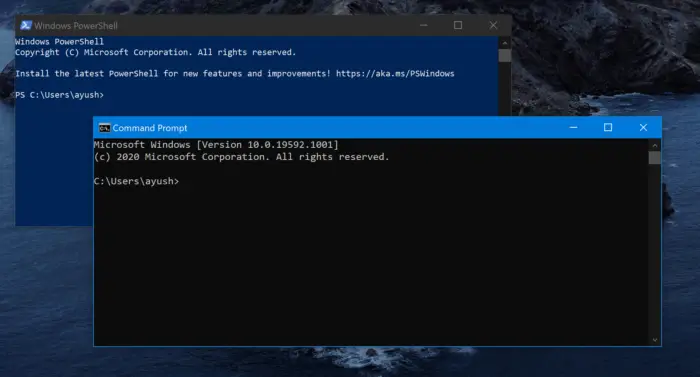
Before you proceed, we recommend you create a System Restore Point so that whenever such errors take place, you can just roll back to the previously known stable state of your computer.
How to Reset PowerShell and Command Prompt to default settings
If you have made changes to PowerShell or Command Prompt default options, you can reset them to default settings in the following ways.
- Reset PowerShell to Default settings in the PowerShell
- Manually reset PowerShell and Command Prompt by replacing shortcuts
Let’s get into the details of each method.
1] Reset PowerShell to Default settings in the PowerShell
This is one of the simple methods to reset PowerShell to default settings. Just run PowerShell as an administrator and right-click on the top bar. Click on Defaults.
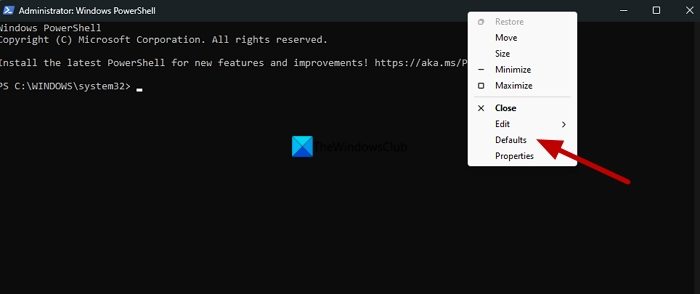
It will open the Console Windows Properties window. Change the settings which you have altered to default manually by clicking on each tab.
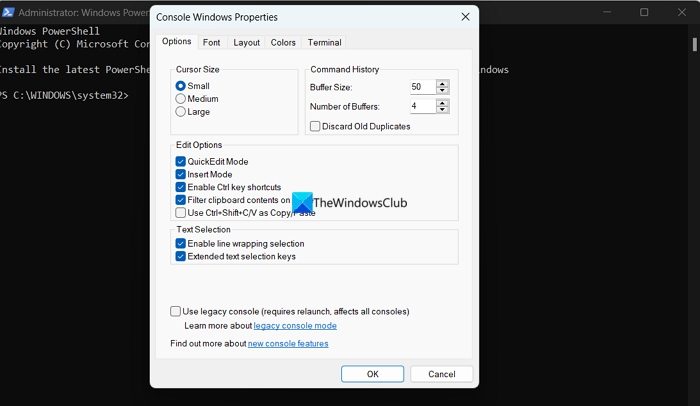
Once you are done with the changes, click on OK to save the changes.
2] Manually reset PowerShell and Command Prompt by replacing shortcuts
There are two variants of Windows PowerShell that are installed on an x64 installation of Windows 11/10 namely:
- Windows PowerShell
- Windows PowerShell (x86).
If you use an x86 installation, there will just be Windows PowerShell.
If you wish to reset Windows PowerShell, you need to replace the shortcut as default. For that, download the default versions of shortcuts for Windows PowerShell and Command Prompt from our servers.
Now, navigate to the following path:
C:\Users\<USERNAME>\AppData\Roaming\Microsoft\Windows\Start Menu\Programs\Windows PowerShell

Here, <USERNAME> defines the user account for which you wish to reset the Windows PowerShell command line.
Now, get any shortcut from our archive and replace it on your computer.
Windows PowerShell on your computer has now been reset to the default settings.
To reset Command Prompt to default settings, you need to use the .reg file you have downloaded earlier. Run the file and if it gives you a security warning, select Run.
Select Yes to the UAC or the User Account Control prompt you get. Then select Yes to the Registry Editor warning prompt that you get.

You will get a message that the registry configuration has been modified.
Reboot your computer and have the Windows Command Prompt with default settings on your computer.
If you wish to do it manually, you can do that too.
Hit the WINKEY + R button combination to launch the Run utility, type in regedit, and hit Enter. Once Registry Editor opens, navigate to the following key-
HKEY_CURRENT_USER\Console
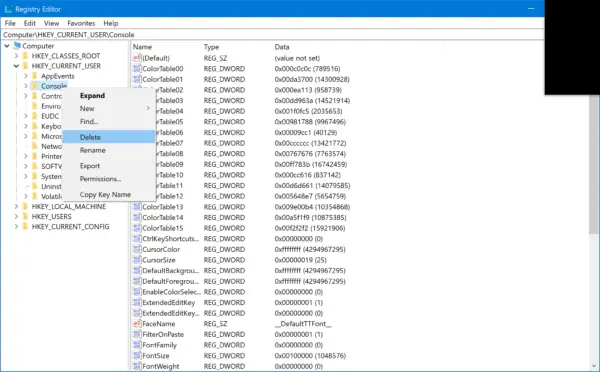
Now, right-click on the folder named Console on the left side panel and click Delete.
Select Yes for the confirmation prompt that you get.
Reboot your computer and you will find Windows Command Prompt reset to default settings on your computer.
Also Read: PowerShell has stopped working
How do I reset CMD to default settings?
To reset the Command prompt or CMD to default settings, you need to do it manually using the Registry Editor. We have provided the Registry file in the post above. Download the Zip file and run the .reg file to replace the Registry Settings which will automatically reset CMD to default settings. It is recommended to backup Registry settings before you make any changes to not mess up features on your Windows 11/10 PC.
How do I change PowerShell to default Command Prompt?
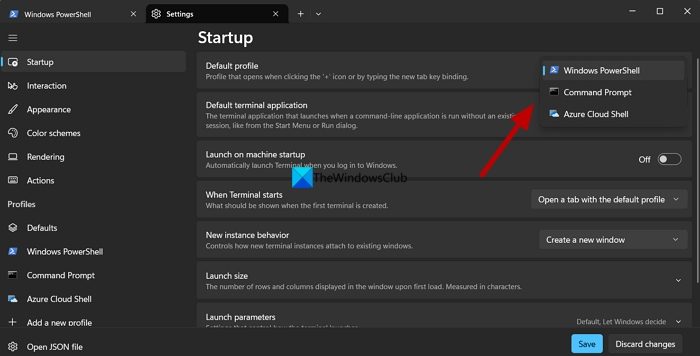
To change PowerShell to default Command Prompt, open PowerShell and open Settings by right-clicking on the top bar and selecting Settings. Then, in the Startup tab, click on the drop-down button beside the Default profile. Select Command Prompt and click on Save to save the changes. It will now automatically open Command Prompt as default in PowerShell.
Related read: How to ALWAYS run Command Prompt, PowerShell, Terminal as Administrator.